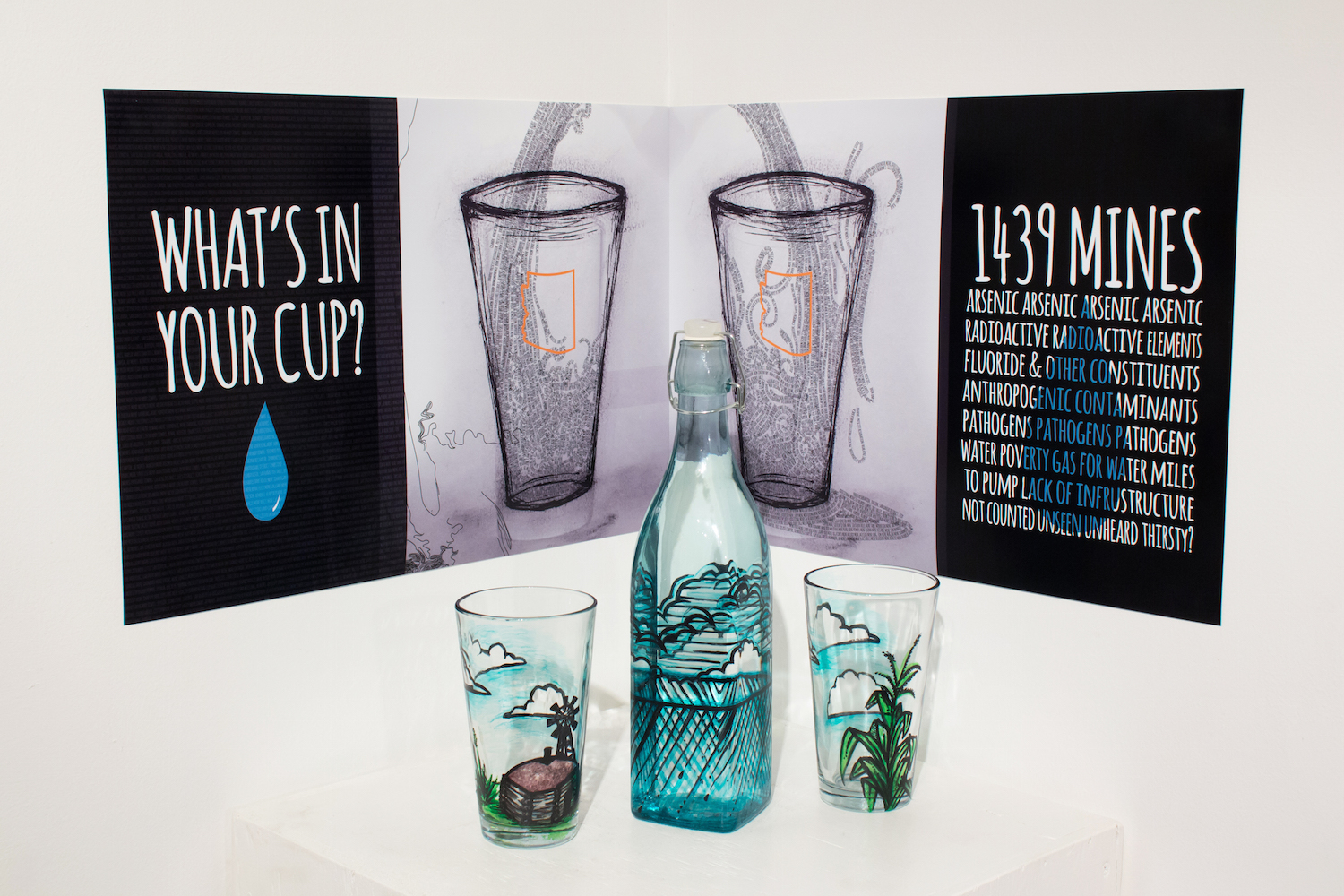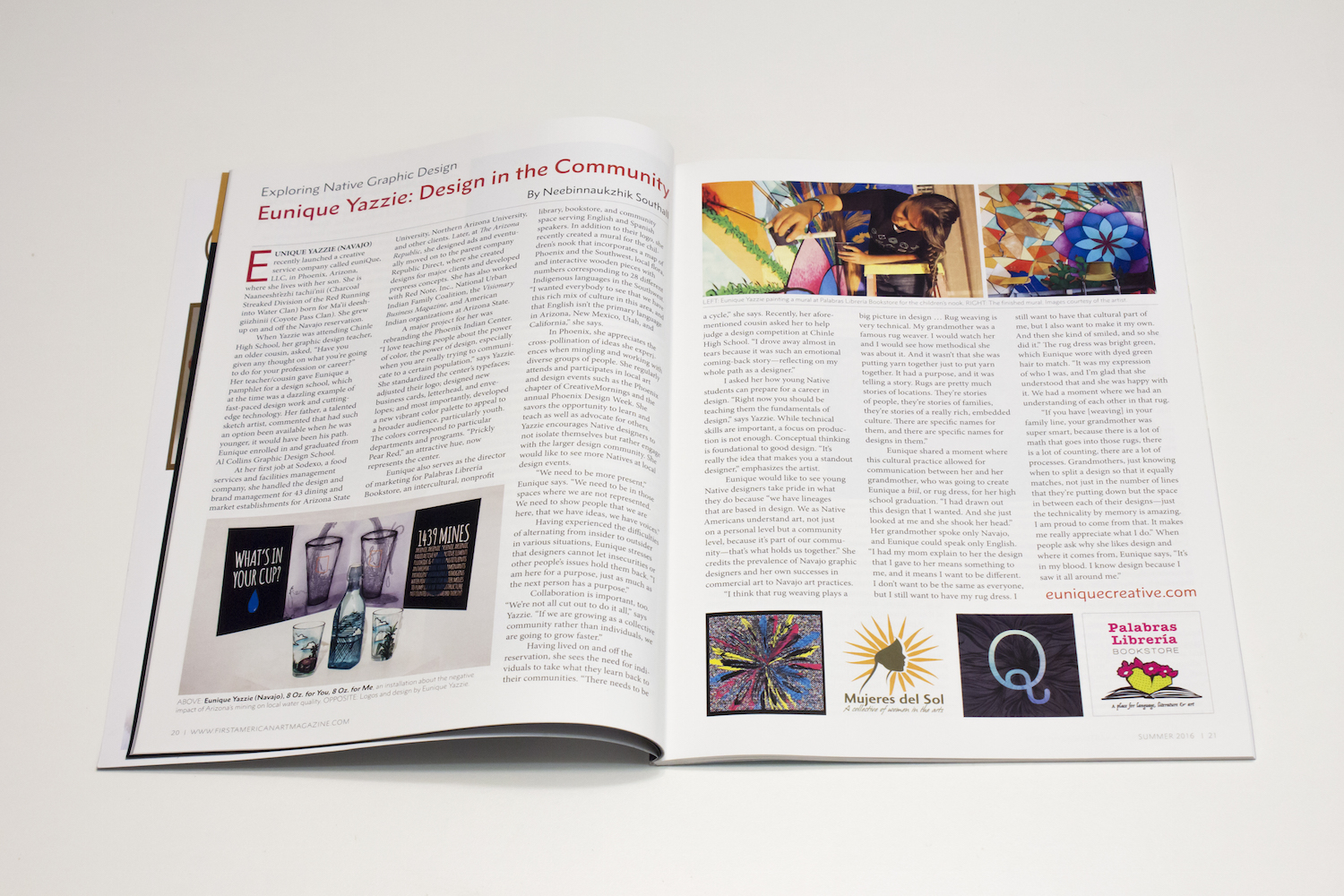
My article, Exploring Native Design: Eunique Yazzie: Design in the Community, featuring Phoenix-based Navajo designer Eunique Yazzie in issue no. 11, Summer 2016, of First American Art Magazine.
Eunique Yazzie: Design in the Community
by Neebinnaukzhik Southall
As appears in First American Art Magazine
EUNIQUE YAZZIE (NAVAJO) recently launched a creative service company called euniQue, LLC, in Phoenix, Arizona, where she lives with her son. She is Naaneesht’ezhi tachii’nii (Charcoal Streaked Division of the Red Running into Water Clan) born for Ma’ii deesh- giizhinii (Coyote Pass Clan). She grew up on and off the Navajo reservation.
When Yazzie was attending Chinle High School, her graphic design teacher, an older cousin, asked, “Have you given any thought on what you’re going to do for your profession or career?” Her teacher/cousin gave Eunique a pamphlet for a design school, which at the time was a dazzling example of fast-paced design work and cutting- edge technology. Her father, a talented sketch artist, commented that had such an option been available when he was younger, it would have been his path. Eunique enrolled in and graduated from Al Collins Graphic Design School.
At her first job at Sodexo, a food services and facilities management company, she handled the design and brand management for 43 dining and market establishments for Arizona State University, Northern Arizona University, and other clients. Later, at The Arizona Republic, she designed ads and eventually moved on to the parent company Republic Direct, where she created designs for major clients and developed prepress concepts. She has also worked with Red Note, Inc., National Urban Indian Family Coalition, the Visionary Business Magazine, and American Indian organizations at Arizona State.
A major project for her was rebranding the Phoenix Indian Center. “I love teaching people about the power of color, the power of design, especially when you are really trying to communicate to a certain population,” says Yazzie. She standardized the center’s typefaces; adjusted their logo; designed new business cards, letterhead, and envelopes; and most importantly, developed a new vibrant color palette to appeal to a broader audience, particularly youth. The colors correspond to particular departments and programs. “Prickly Pear Red,” an attractive hue, now represents the center.
Eunique also serves as the director of marketing for Palabras Librería Bookstore, an intercultural, nonprofit library, bookstore, and community space serving English and Spanish speakers. In addition to their logo, she recently created a mural for the children’s nook that incorporates a map of Phoenix and the Southwest, local flora, and interactive wooden pieces with numbers corresponding to 28 different Indigenous languages in the Southwest.
“I wanted everybody to see that we have this rich mix of culture in this area, and that English isn’t the primary language in Arizona, New Mexico, Utah, and California,” she says.
In Phoenix, she appreciates the cross-pollination of ideas she experiences when mingling and working with diverse groups of people. She regularly attends and participates in local art
and design events such as the Phoenix chapter of CreativeMornings and the annual Phoenix Design Week. She savors the opportunity to learn and teach as well as advocate for others. Yazzie encourages Native designers to not isolate themselves but rather engage with the larger design community. She would like to see more Natives at local design events.
“We need to be more present,” Eunique says. “We need to be in those spaces where we are not represented. We need to show people that we are here, that we have ideas, we have voices.”
Having experienced the difficulties of alternating from insider to outsider in various situations, Eunique stresses that designers cannot let insecurities or other people’s issues hold them back. “I am here for a purpose, just as much as the next person has a purpose.”
Collaboration is important, too. “We’re not all cut out to do it all,” says Yazzie. “If we are growing as a collective community rather than individuals, we are going to grow faster.”
Having lived on and off the reservation, she sees the need for individuals to take what they learn back to their communities. “There needs to be a cycle,” she says. Recently, her aforementioned cousin asked her to help judge a design competition at Chinle High School. “I drove away almost in tears because it was such an emotional coming-back story—reflecting on my whole path as a designer.”
I asked her how young Native students can prepare for a career in design. “Right now you should be teaching them the fundamentals of design,” says Yazzie. While technical skills are important, a focus on production is not enough. Conceptual thinking is foundational to good design. “It’s really the idea that makes you a standout designer,” emphasizes the artist.
Eunique would like to see young Native designers take pride in what they do because “we have lineages that are based in design. We as Native Americans understand art, not just on a personal level but a community level, because it’s part of our community—that’s what holds us together.” She credits the prevalence of Navajo graphic designers and her own successes in commercial art to Navajo art practices.
“I think that rug weaving plays a big picture in design … Rug weaving is very technical. My grandmother was a famous rug weaver. I would watch her and I would see how methodical she was about it. And it wasn’t that she was putting yarn together just to put yarn together. It had a purpose, and it was telling a story. Rugs are pretty much stories of locations. They’re stories of people, they’re stories of families, they’re stories of a really rich, embedded culture. There are specific names for them, and there are specific names for designs in them.”
Eunique shared a moment where this cultural practice allowed for communication between her and her grandmother, who was going to create Eunique a biil, or rug dress, for her high school graduation. “I had drawn out this design that I wanted. And she just looked at me and she shook her head.” Her grandmother spoke only Navajo, and Eunique could speak only English.
“I had my mom explain to her the design that I gave to her means something to me, and it means I want to be different. I don’t want to be the same as everyone, but I still want to have my rug dress. I still want to have that cultural part of me, but I also want to make it my own. And then she kind of smiled, and so she did it.” The rug dress was bright green, which Eunique wore with dyed green hair to match. “It was my expression of who I was, and I’m glad that she understood that and she was happy with it. We had a moment where we had an understanding of each other in that rug.
“If you have [weaving] in your family line, your grandmother was super smart, because there is a lot of math that goes into those rugs, there is a lot of counting, there are a lot of processes. Grandmothers, just knowing when to split a design so that it equally matches, not just in the number of lines that they’re putting down but the space in between each of their designs—just the technicality by memory is amazing. I am proud to come from that. It makes me really appreciate what I do.” When people ask why she likes design and where it comes from, Eunique says, “It’s in my blood. I know design because I saw it all around me.”
